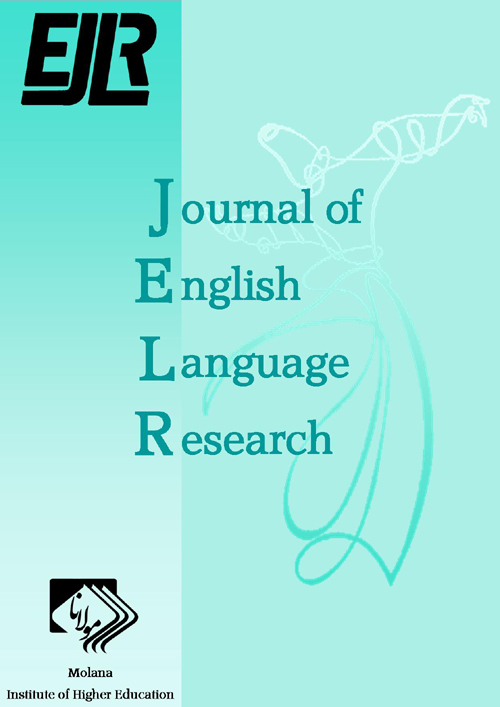فهرست مطالب

Journal of English Language Research
Volume:3 Issue: 1, Jul 2022
- تاریخ انتشار: 1401/05/29
- تعداد عناوین: 5
-
Pages 1-13
The necessity of the adoption of online teaching during the spread of COVID-19 has made the researchers’ focus on computer-assisted language learning (CALL). As a preliminary for using technology in language teaching, the present study aims to find the attitude of Iranian EFL teachers towards using a computer in language instruction as well as their competence in working with computers. The existence of any relationship between these two variables has also been under investigation in the study. For this purpose, a group of 153 available EFL teachers teaching in different language contexts in Iran were selected as the participants of the study. They were asked to answer two validated questionnaires: The computer Attitude questionnaire and the Computer Competency questionnaire considering their ability in practically working with some specific software before the survey. The obtained results revealed the positive attitude of Iranian EFL teachers towards CALL and their agreement for the implementation of computers in their language teaching programs. Moreover, the participants were reported to have a moderate and appropriate level of computer competence, indicating their ability to run computer-based classes. Using Pearson correlation and regression tests, a moderate positive relationship was found between Iranian EFL teachers’ attitude towards CALL and their knowledge of computer programs. However, the teachers’ computer competence could not significantly affect their attitude towards using a computer for language teaching. The findings implicated the need for computer knowledge enhancement among Iranian EFL teachers through some training courses, in addition to teachers’ readiness for adopting technology and computer in their instructions.
Keywords: Attitude, CALL, Competence, EFL Teacher -
Pages 15-25
This study investigated whether using different types of glosses makes any significant difference in intentional vocabulary learning. It employed a pretest/post-test design with five treatment sessions. For this purpose, a total number of 40 Iranian EFL learners were assigned randomly into four groups, one control, and three experimental groups, to read five English passages under four different glossing conditions: text–picture (TPG), text– warm-up (TWG), text–audio (TAG) and no glosses (NOG). Then, a post-test was performed to measure their vocabulary learning scores. The findings indicated that, firstly, introducing glosses positively affects the intentional vocabulary learning scores. Then the students of the TWG outperformed compared to those of the control group and other experimental groups. Finally, there were no significant differences among other types of glossing regarding vocabulary learning scores. This finding implies that applying glossing techniques in teaching reading materials helps improve vocabulary learning compared to traditional ways.
Keywords: Aiding Tools, Glossing, Reading Comprehension, Teaching Technique, Vocabulary -
Pages 27-38
This study aims at exploring the interactive Metadiscourse markers applied in TEFL textbooks written by native and non-native authors. It is done based on Hyland's (2005) categorization. To this end, four TEFL textbooks on testing and material development, written by English and Iranian authors, were selected. The corpus was analyzed using Wordsmith software. Finally, interactive markers applied in the textbooks were compared. The analysis indicated that there are similarities and differences in using the markers between the two groups. The most noticeable similarity is that transitions are the most frequently used markers. There are also other variations in the application of interactive markers, which may be attributed to variations in rhetorical strategies, cultural conventions, and idiosyncratic writing styles of the authors.
Keywords: Interactive dimension, Metadiscourse, Native authors, Non-native authors, Textbook -
Pages 39-54
Textbooks are an indispensable part of ELT. Meanwhile, higher-order thinking plays an important role in our lives, and it has a long-lasting impact on all parts of society, such as education, job, etc. Therefore, given the importance of this criterion, this study aims at comparing EGP textbooks with ESP textbooks to see which group of textbooks is more significant in terms of higher-order thinking skills of creating, evaluating, and analyzing. To this end, the activities of the odd-numbered lessons in 12 ESP textbooks and four EGP book series were analyzed based on Anderson’s (2001) revised taxonomy of bloom. The findings revealed that there is a significant difference between ESP and EGP textbooks in terms of higher-order thinking as well as lower-order thinking. The higher-order thinking activities were more dominant in ESP textbooks. In sharp contrast, lower-order thinking was more dominant in EGP textbooks. Therefore, the findings substantiated that the ESP books are more effective in helping learners and educators promote the higher-order thinking than EGP textbooks.
Keywords: EGP, ESP, Higher-order thinking, Lower-order thinking, Textbooks -
Pages 55-66
The purpose of the current study was to explore the effect of visually enhanced material instruction on EFL students’ speaking skills. For this purpose, forty-five Iranian pre-intermediate EFL students in four intact classes were selected through convenience sampling and received instruction, of which 23 comprised the treatment group and 22 comprised the control group. During Autumn 2021, the treatment group received visual material instruction in speaking skills for approximately 60 minutes per week, which lasted for ten weeks. The Control group received material for speaking skills that lacked photos and movies using traditional teaching methods (i.e., oral topic-based and teacher-fronted) for the same amount of time as the treatment group. Two picture descriptions were used as pre-test and post-test to evaluate students' level of speaking skills. To perform statistical analysis, paired samples t-tests and independent samples t-tests were run. The results showed that the treatment group outperformed the control group on speaking skills. In order to benefit from the positive effect of visual materials on speaking skills, instructors should spend more time on teaching students how to use them, not just familiarizing learners with visual materials. These findings offer practical and theoretical implications for using visual materials in the EFL context.
Keywords: Instructional material, Pre-intermediate, Speaking skill, Visual material

